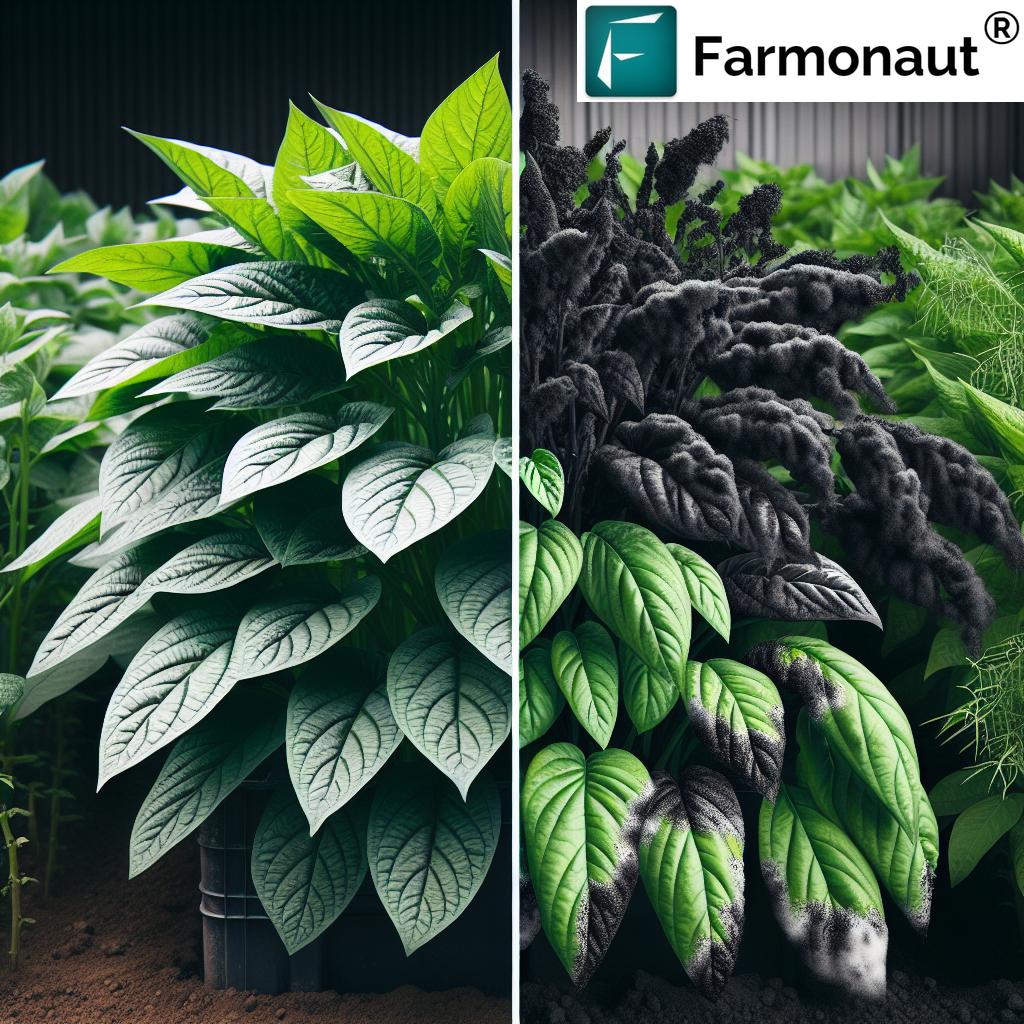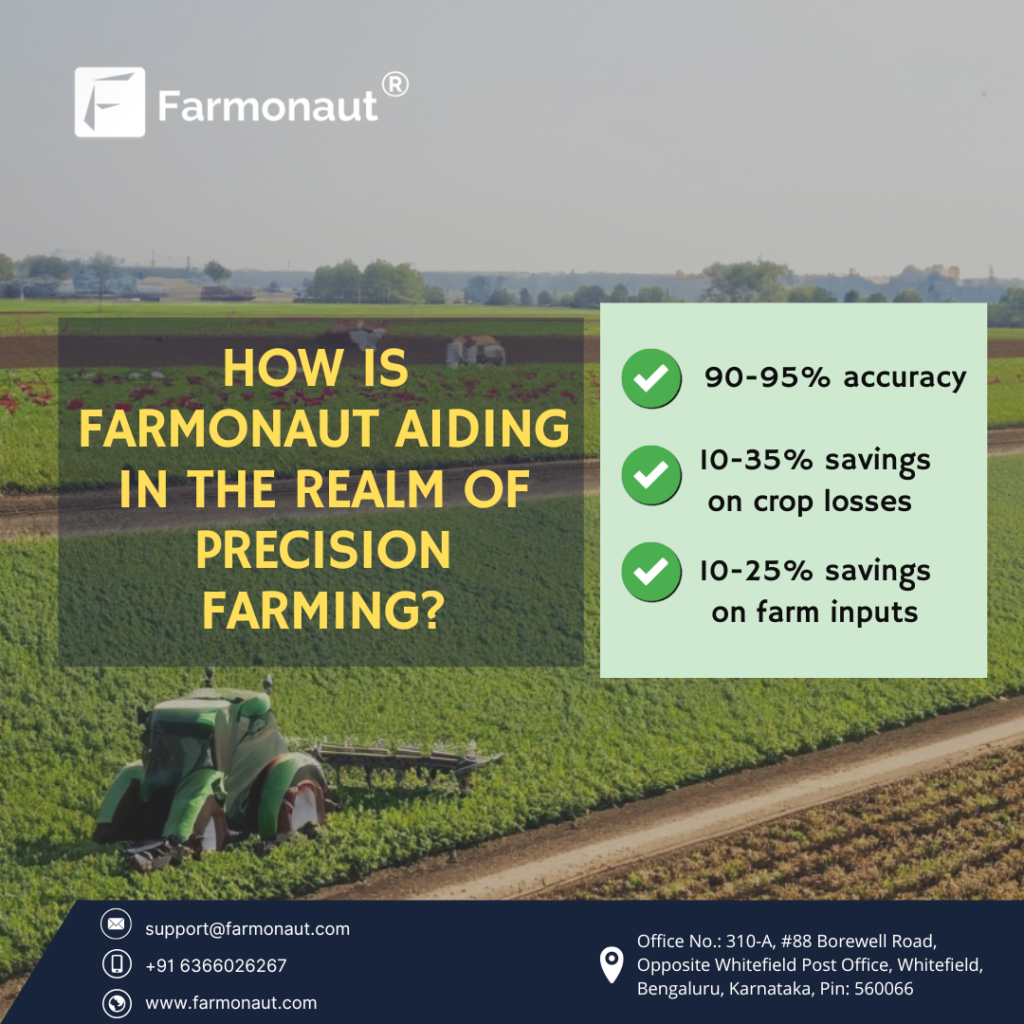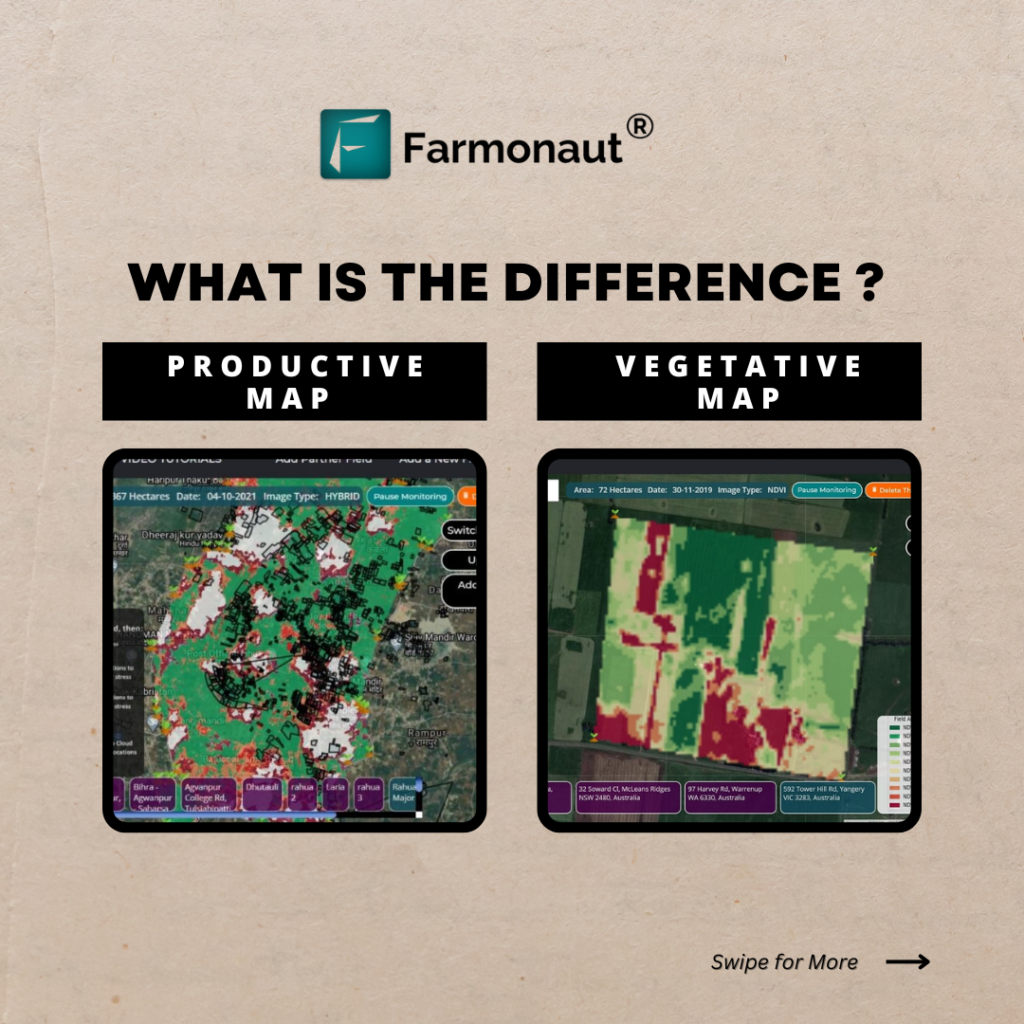Organic Pest Control: Protecting Crops from Honeydew-Secreting Insects and Sooty Mold

In the world of agriculture, the battle against pests is an ongoing challenge that farmers face every day. At Farmonaut, we understand the importance of protecting crops from harmful insects and the secondary problems they can cause. In this comprehensive guide, we’ll explore the intricate relationship between honeydew-secreting insects, sooty mold, and the impact they have on plant health. We’ll also delve into effective organic pest control methods and how our advanced satellite-based technology can help farmers detect and manage these issues more efficiently.
Understanding Honeydew-Secreting Insects and Their Impact on Crops
Honeydew-secreting insects are a group of pests that pose a significant threat to various crops. These insects feed on plant sap and excrete a sugary substance known as honeydew. The most common honeydew-producing pests include:
- Aphids: Small, soft-bodied insects that cluster on leaves and stems
- Mealybugs: Oval-shaped insects covered in a white, waxy coating
- Whiteflies: Tiny, white, winged insects that congregate on the undersides of leaves
- Scales: Immobile insects with hard or soft protective coverings
- Cicadas: Large insects known for their distinctive sound and occasional outbreaks
These pests can cause direct damage to plants by feeding on their sap, which can lead to:
- Stunted growth
- Yellowing or curling of leaves
- Reduced crop yields
- Transmission of plant viruses
However, the problems don’t stop there. The honeydew secretions from these insects create an additional set of challenges for farmers.
The Honeydew Problem: A Sweet Invitation for Trouble
Honeydew is a sticky, sugary substance that these insects excrete as they feed on plant sap. While it might sound harmless, this sweet secretion can lead to several issues:
- Attraction of Other Pests: The sugary nature of honeydew attracts ants and other insects, which can further damage crops or protect the honeydew-producing pests from natural predators.
- Reduced Photosynthesis: Honeydew can coat leaves, blocking sunlight and reducing the plant’s ability to photosynthesize effectively.
- Sooty Mold Growth: Perhaps the most significant problem associated with honeydew is that it provides an ideal growing medium for sooty mold.
Sooty Mold: The Dark Consequence of Honeydew

Sooty mold is a type of fungi that thrives on the honeydew secreted by insects. It appears as a black, soot-like coating on leaves, stems, and fruits. While sooty mold doesn’t directly infect plants, its presence can have several negative effects:
- Reduced Sunlight Absorption: The dark coating blocks sunlight, interfering with photosynthesis and potentially stunting plant growth.
- Decreased Plant Vigor: As photosynthesis is impaired, plants become weaker and more susceptible to other stresses and diseases.
- Lower Crop Quality: For fruit and vegetable crops, sooty mold can make produce unattractive and potentially unmarketable.
- Reduced Air Exchange: The mold can clog leaf stomata, affecting the plant’s ability to respire and regulate water loss.
Understanding the relationship between honeydew-secreting insects and sooty mold is crucial for developing effective pest control strategies. At Farmonaut, we believe in empowering farmers with knowledge and tools to combat these issues effectively.
Detecting Honeydew-Secreting Insects and Sooty Mold Infestations
Early detection is key to managing pest infestations and preventing the spread of sooty mold. Here’s how farmers can identify these problems:
Signs of Honeydew-Secreting Insect Infestations:
- Clusters of small insects on leaves, stems, or fruit
- Sticky, shiny substances on plant surfaces
- Presence of ants, which are attracted to honeydew
- Yellowing or curling of leaves
- Stunted plant growth
Indicators of Sooty Mold:
- Black, powdery coating on leaves, stems, or fruit
- Dull appearance of plant foliage
- Reduced plant vigor
- Premature leaf drop
While traditional scouting methods are useful, they can be time-consuming and may miss early signs of infestation, especially in large fields. This is where Farmonaut’s satellite-based crop monitoring technology comes into play.
Farmonaut’s Satellite-Based Detection: A Game-Changer in Pest Management
At Farmonaut, we leverage advanced satellite imagery and artificial intelligence to provide farmers with early warning systems for pest infestations and plant stress. Our technology offers several advantages over traditional detection methods:
| Method | Detection Speed | Accuracy | Coverage Area | Cost-Effectiveness |
|---|---|---|---|---|
| Traditional Scouting | Slow | Moderate | Limited | Low |
| Farmonaut’s Satellite-Based System | Fast | High | Extensive | High |
Our satellite-based system can quickly identify areas of plant stress, which may indicate pest infestations or the presence of sooty mold. By analyzing multispectral imagery, we can detect changes in plant health before they become visible to the naked eye. This allows farmers to:
- Monitor large areas efficiently
- Detect problems early, enabling timely intervention
- Target treatments more precisely, reducing costs and environmental impact
- Track the effectiveness of pest control measures over time
To learn more about how our satellite-based crop monitoring can revolutionize your pest management strategy, visit Farmonaut’s App.
Organic Pest Control Strategies for Honeydew-Secreting Insects
At Farmonaut, we advocate for sustainable farming practices that protect both crops and the environment. Here are some effective organic pest control strategies for managing honeydew-secreting insects:
1. Biological Control
Introducing natural predators and parasites can help keep pest populations in check. Some effective biocontrol agents include:
- Ladybugs
- Lacewings
- Parasitic wasps
- Predatory mites
2. Cultural Practices
Implementing good cultural practices can make your crops less attractive to pests:
- Crop rotation
- Intercropping with pest-repellent plants
- Proper irrigation and fertilization to promote plant health
- Removal of infected plant material
3. Physical Barriers
Creating physical barriers can prevent pests from reaching your crops:
- Row covers
- Insect-proof netting
- Sticky traps
4. Organic Pesticides
When other methods aren’t sufficient, organic pesticides can be used:
- Neem oil
- Insecticidal soaps
- Pyrethrin-based sprays
- Diatomaceous earth
5. Plant-Based Repellents
Certain plants and plant extracts can repel honeydew-secreting insects:
- Garlic spray
- Chili pepper spray
- Essential oils (peppermint, rosemary, thyme)
Combating Sooty Mold: Organic Approaches
While controlling honeydew-secreting insects is the primary way to prevent sooty mold, there are additional steps farmers can take to manage existing mold problems:
1. Pruning and Removal
Remove heavily infested plant parts to prevent the spread of mold and improve air circulation.
2. Organic Fungicides
Apply organic fungicides such as copper-based solutions or potassium bicarbonate to control mold growth.
3. Horticultural Oils
Use horticultural oils to suffocate insects and help loosen sooty mold for easier removal.
4. Compost Teas
Apply compost teas to boost plant immunity and promote beneficial microorganisms that can outcompete sooty mold.
5. Foliar Sprays
Use organic foliar sprays to clean leaves and discourage mold growth.
Integrating Farmonaut’s Technology with Organic Pest Control
At Farmonaut, we believe that combining traditional organic pest control methods with modern technology can yield the best results. Our satellite-based crop monitoring system can enhance your pest management strategy in several ways:
- Early Detection: Identify pest hotspots and areas of plant stress before they become visible to the naked eye.
- Targeted Treatment: Use our precision maps to apply organic pesticides and treatments only where needed, reducing costs and environmental impact.
- Monitoring Effectiveness: Track the success of your pest control measures over time with regular satellite imagery updates.
- Data-Driven Decisions: Use our AI-powered insights to make informed decisions about when and where to implement different pest control strategies.
To integrate our technology into your organic pest management plan, visit our Farmonaut API page or download our mobile app for Android or iOS.
The Future of Organic Pest Control: Precision and Sustainability
As we look to the future, the integration of technology with organic farming practices holds immense promise. At Farmonaut, we’re continuously developing new ways to support sustainable agriculture:
- AI-Powered Pest Prediction: Our machine learning algorithms are being trained to predict pest outbreaks based on historical data, weather patterns, and crop health indicators.
- Drone Integration: We’re exploring ways to combine satellite imagery with drone-captured data for even more precise pest detection and treatment.
- IoT Sensors: Integration with on-ground sensors can provide real-time data on pest populations and environmental conditions.
- Blockchain Traceability: Our blockchain solutions can help organic farmers verify and showcase their pest management practices to consumers.
For more information on our latest developments and how they can benefit your organic farming practices, check out our API documentation.
Conclusion: Empowering Organic Farmers with Technology
The challenge of managing honeydew-secreting insects and sooty mold in organic farming is significant, but not insurmountable. By combining time-tested organic pest control methods with Farmonaut’s cutting-edge satellite technology, farmers can protect their crops more effectively than ever before.
We believe that the future of agriculture lies in sustainable, technology-enhanced practices that work in harmony with nature. Our mission at Farmonaut is to make these advanced tools accessible to farmers of all sizes, empowering them to grow healthy, productive crops while minimizing environmental impact.
Ready to take your organic pest management to the next level? Explore our subscription options below and join the Farmonaut community today!
Frequently Asked Questions (FAQ)
Q: What are honeydew-secreting insects?
A: Honeydew-secreting insects are pests that feed on plant sap and excrete a sugary substance called honeydew. Common examples include aphids, mealybugs, whiteflies, scales, and cicadas.
Q: How does honeydew affect plants?
A: Honeydew can attract other pests, reduce photosynthesis by coating leaves, and provide a growth medium for sooty mold, which can further damage plants.
Q: What is sooty mold?
A: Sooty mold is a type of fungi that grows on the honeydew secreted by insects. It appears as a black, soot-like coating on plant surfaces and can interfere with photosynthesis and plant health.
Q: How can I detect honeydew-secreting insects and sooty mold early?
A: Look for clusters of small insects, sticky substances on plants, presence of ants, yellowing leaves, and black, powdery coatings on plant surfaces. Farmonaut’s satellite-based technology can also help detect plant stress early, which may indicate pest infestations.
Q: What are some organic methods to control honeydew-secreting insects?
A: Organic control methods include biological control (using natural predators), cultural practices (crop rotation, intercropping), physical barriers, organic pesticides, and plant-based repellents.
Q: How can Farmonaut’s technology help with pest management?
A: Farmonaut’s satellite-based crop monitoring can detect plant stress early, identify pest hotspots, enable targeted treatments, and track the effectiveness of pest control measures over time.
Q: Is it possible to combine organic pest control with modern technology?
A: Yes, integrating organic methods with technologies like Farmonaut’s satellite monitoring can enhance pest management strategies, making them more efficient and effective.
Q: How often should I monitor my crops for pests?
A: Regular monitoring is crucial. With traditional methods, weekly inspections are recommended. Using Farmonaut’s technology, you can receive frequent updates on crop health, allowing for continuous monitoring.
Q: Can sooty mold be removed from plants?
A: Yes, sooty mold can be removed by pruning affected parts, using organic fungicides, horticultural oils, or foliar sprays. However, controlling the underlying insect infestation is key to preventing its return.
Q: Are organic pest control methods as effective as conventional pesticides?
A: When implemented correctly and combined with modern technologies like Farmonaut’s satellite monitoring, organic pest control methods can be highly effective while being more sustainable and environmentally friendly than conventional pesticides.












